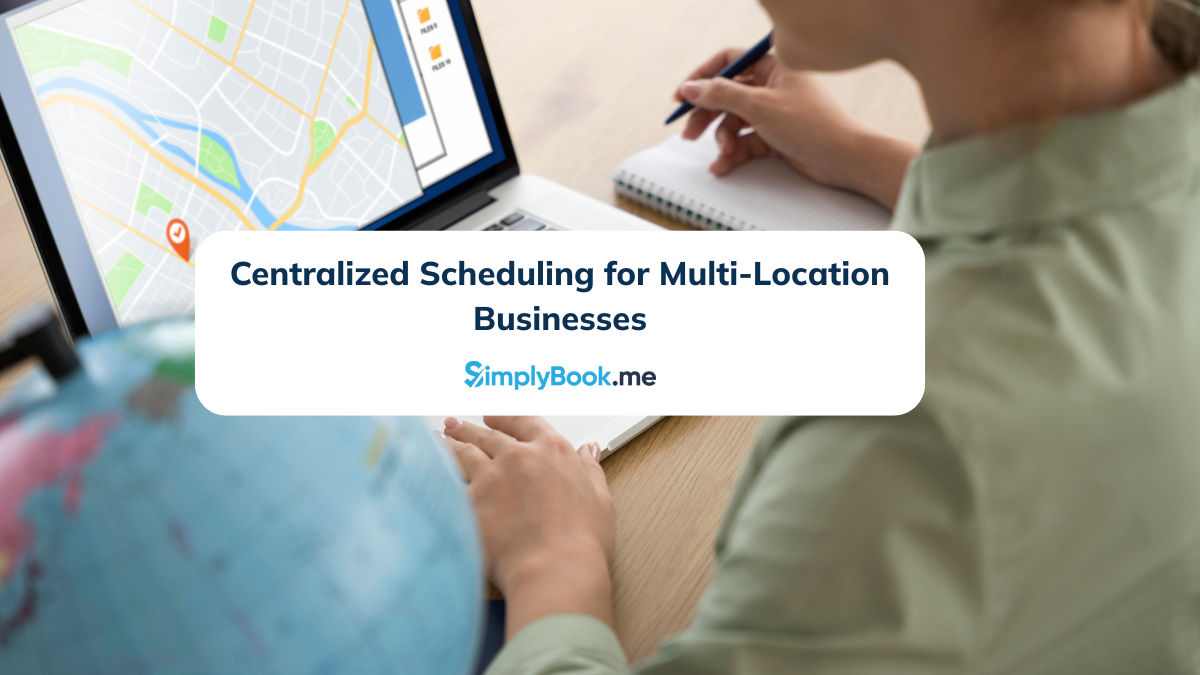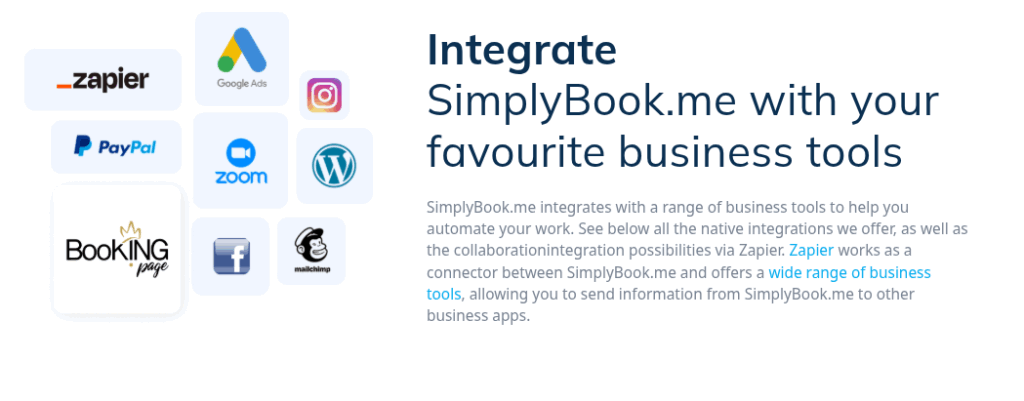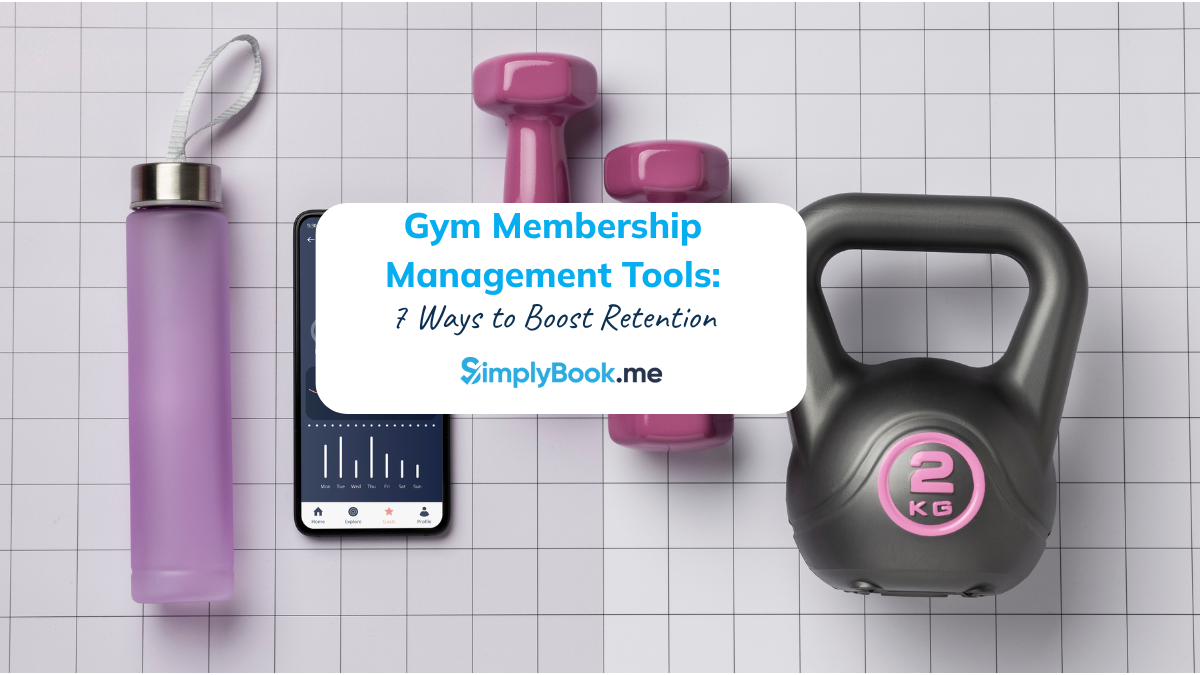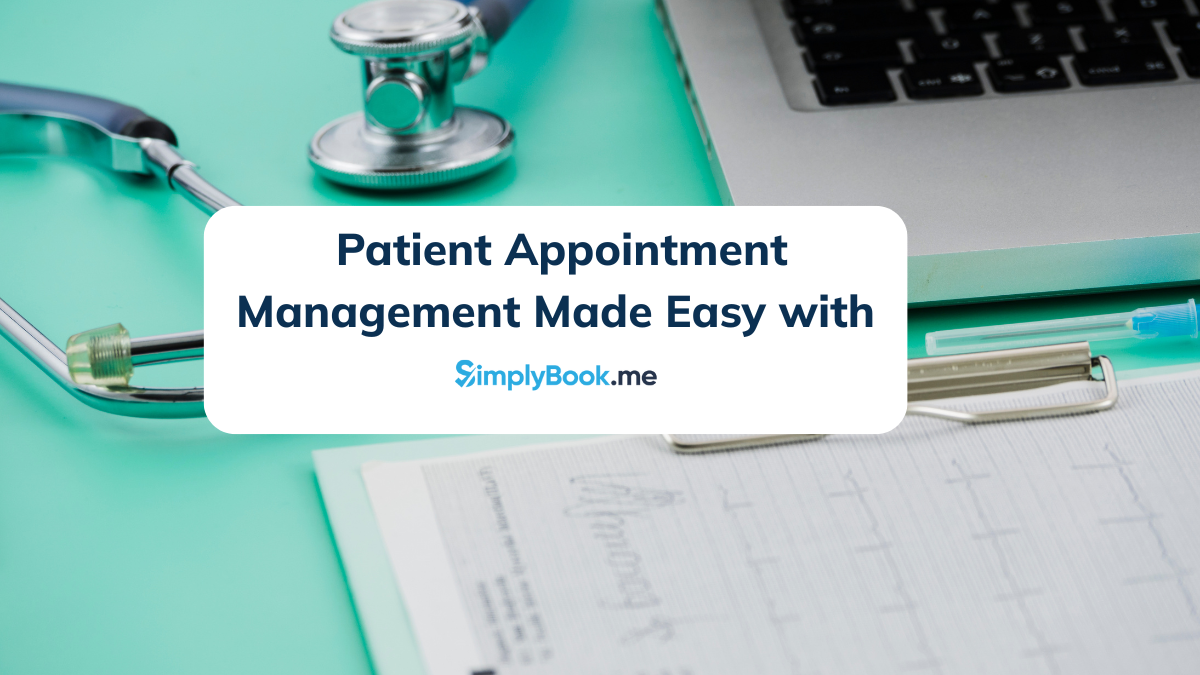Centralized Scheduling for Multi-Location Businesses

Managing schedules across multiple locations is hard. When you’re juggling staff shifts, customer appointments, and service availability across branches, the struggle is real.
Using separate scheduling tools at each location leads to errors, overlap, and frustrated customers. The cost? Lost income, stressed staff, and customers choosing competitors.
Centralized scheduling fixes this problem. With one system for all your locations, like SimplyBook.me, you get a single source of truth.
When staff know where and when to work, customers enjoy the same reliable experience no matter which location they visit.
A strong centralized scheduling system doesn’t just keep appointments in order; it keeps your entire operation running smoothly, ensuring managers, staff, and customers all stay on the same page.

What Is Centralized Scheduling?
At its core, centralized scheduling is about managing all employee shifts, appointments, and resources from a single system, rather than relying on separate tools at each location.
For a multi-location business, it provides real-time visibility across all branches, helping managers see staffing needs, avoid conflicts, and optimize operations.
It’s not just about convenience; centralized scheduling brings consistency, prevents mistakes, and keeps all your locations running efficiently.
A single, unified system lets managers move staff between locations, deal with last-minute changes, and make sure everyone knows exactly where and when they’re needed.

Key Benefits of Centralized Scheduling
Managing a multi-location business means coordinating staff and schedules across different branches. It’s a lot to keep track of, and mistakes happen.
Centralized scheduling ends the chaos with one dashboard that shows everything, so you spot problems early and keep every branch up and running.
That means less stress for you and better service for your customers.
Here’s how centralized scheduling makes a real difference:
Boosted Productivity
Managing schedules across multiple locations takes forever when you’re jumping between systems.
Centralized scheduling changes that. Now you see everything in one place so that you can assign shifts and detect gaps in minutes.
That means managers spend less time dealing with schedules and more time actually running the business.
Companies that adopt centralized scheduling report significant productivity gains.
For example, studies show up to a 20% improvement in productivity and 30% fewer scheduling errors, demonstrating how a unified scheduling system optimizes workforce management across multiple locations.
Consistent Staffing Across All Locations
Multi-location businesses struggle with balance. One branch might be overstaffed while another desperately needs help.
This inconsistency shows up in your service quality, and customers pick up on it fast.
Centralized scheduling lets you see the full picture across all your locations. You identify gaps before they become problems and make sure every branch has the coverage it needs to deliver great service.
Tools like SimplyBook.me help you keep teams aligned across every location, ensuring consistent quality wherever customers book.
Labor Cost Control
Centralized scheduling saves you money. Instead of wasting payroll on overstaffed locations, you can see exactly where you need people.
That means you stop paying expensive overtime just to cover your busy branches.
When one location gets unexpectedly busy, you simply move someone from a slower branch rather than paying overtime rates. As a result, you cut labor costs while still keeping service quality high.
According to a 2025 KPMG report on workforce efficiency, organizations implementing centralized scheduling have optimized labor costs by significantly reducing overtime, agency, and incentive pay.
Managers can see the financial impact of staffing before making decisions, helping them use resources wisely and save money across all locations.
Improved Communication
Communication breaks down fast when your team works in various branches. Someone misses a schedule change, while another person doesn’t get the memo about a new policy.
Before you know it, you’re dealing with no-shows and confusion. Centralized scheduling solves this by keeping everyone connected through one system.
When managers send updates, they reach all locations instantly. At the same time, staff get automatic notifications about their shifts, so they’re never caught off guard.
Plus, everyone can communicate directly through the platform, eliminating the gaps that cause scheduling problems.
The impact is clear: centralized scheduling gives you better productivity, lower labor costs, stronger communication, and consistent service across all your locations.

How Centralized Scheduling Works: A Step-by-Step Guide
Centralized scheduling connects all your locations in one system.
You see staff, appointments, and availability across every branch in real time. Instead of managing separate calendars, you control everything from one dashboard.
Here’s how it works in practice:
Step 1: Create One Central Dashboard
All your schedules live in one place: staff shifts, appointments, equipment, and room bookings. Rather than opening different spreadsheets or tools for each location, you check availability across all branches from a single screen. This saves time and puts an end to confusion right from the start.
Step 2: Prevent Conflicts Before They Happen
The system spots problems early and warns about double bookings or overlaps. If one location is busy, you can move staff from a quieter place.
Step 3: Control Who Sees What
Managers get a complete view across all locations, while staff only see their own schedules and relevant appointments. This keeps things organized and protects sensitive information. Everyone gets exactly what they need without the clutter.
Step 4: Connect Your Other Business Tools
Modern centralized scheduling platforms work with your existing systems: POS, CRM software, and social media apps. Everything talks to each other, so you’re not entering the same information twice. Your whole operation runs on one set of accurate data.

Choosing the Right Centralized Scheduling System
Once you decide to move to centralized scheduling, the next question is: Which system actually fits your business?
Not all tools are built for companies operating across multiple locations, and picking the wrong platform can leave you right back where you started: managing chaos, just in a more polished system.
A strong centralized scheduling system should make your locations feel connected, not complicated.
Consider these factors when evaluating your options:
True Multi-Location Support
Some tools say they handle multiple locations, yet they still use separate calendars. A true centralized system shows all branches in one dashboard with no extra steps.
Real-Time Syncing Across All Branches
In a busy business, schedules change all the time. That’s why your system should update instantly across all locations. If it’s slow or needs manual updates, it won’t keep up.
Smart Automation That Saves Time
Choose a system that can automatically assign shifts, spot conflicts, and follow your scheduling rules. When it handles things like availability, skills, and breaks on its own, managers save hours every week.
Don’t think of automation as just a nice extra; it’s what keeps multi-location scheduling accurate.
Built-In Communication Tools
Every schedule change should come with automatic notifications. Managers should be able to send updates to one location or all locations at once. And staff should have a simple way to confirm shifts or send questions.
Flexible Resource Management
A good platform lets you manage more than staff. You should be able to track rooms, equipment, and service availability across locations. This matters especially for healthcare providers, salons, personal training studios where resources move or rotate.
Cross-Location Staffing Support
One of the biggest advantages of centralized scheduling is the ability to shift staff from quieter locations to busier ones. Your system should make this simple, ideally with drag-and-drop tools and real-time availability filtering.
Integrations With Your Existing Tools
Your scheduling platform should connect with the tools you already use: POS systems, CRMs, payment gateways, and social media apps. This keeps your whole operation running off one trustworthy data source.
Scalability as You Grow
Choose a system that won’t collapse under the weight of new branches or new staff. If your business plans to expand, your scheduling platform should be able to handle more appointments, more complexity, and more locations without slowing down.

Why SimplyBook.me Stands Out for Multi-Location Centralized Scheduling
Choosing the right scheduling platform matters, especially when you’re managing a large team or high booking volume.
SimplyBook.me is designed with these challenges in mind, offering the tools multi-location businesses need to stay organized, consistent, and connected across every site.
What distinguishes it from the rest:
Built for Multi-Location Management
Plenty of scheduling tools claim to handle multiple locations, but SimplyBook.me actually makes it simple. You get one dashboard that shows all your branches. Staff assignments happen with a few clicks. And you never need to switch between different systems to organize services.
Consistent Booking Experience Across All Locations
No matter which location a customer visits, the experience is the same, and you can set each branch’s schedule, services, and staff while keeping your brand consistent, which is a big advantage for growing businesses.
Automation That Cuts Down Manual Work
It automates nearly every step: confirming appointments, sending reminders and follow-ups, managing cancellations and buffer times, and keeping your staff in the loop.
Flexible Custom Features (Over 70 of Them)
Every multi-location business runs a little differently. SimplyBook.me offers an extensive library of custom features you can activate as needed, without coding or extra plugins.
Examples include:
- Memberships
- Packages
- Service add-ons
- Intake forms
- Point-of-sale
- Resource management
- Multi-lingual and multi-currency support
Cross-Location Staff and Resource Visibility
Managers can quickly check who’s available, where, and when. If one branch gets busy, you can easily reassign staff or open additional slots. This flexibility is key for service businesses with shifting demand.
Enterprise-Level Security and Reliability
For multi-site businesses, stability and privacy matter. SimplyBook.me uses secure infrastructure with advanced encryption, GDPR compliance, and role-based access control, so every location stays protected.
Integrations That Keep Everything Connected
SimplyBook.me connects smoothly with tools you already rely on:
- Google Calendar
- Zoom
- QuickBooks
- Mailchimp
- CRM systems
- Payment gateways
This reduces double work and keeps your data consistent across all systems.

Getting the Most from Centralized Scheduling
Adopting centralized scheduling isn’t just about new software; it’s about running your multi-location business smarter.
The platform does the essentials, but how you use it determines your results.
Here’s how to maximize your investment:
Get Your Team On Board
The best system fails if your staff won’t use it. Start with simple training: show employees how to check their shifts, update availability, and communicate through the platform.
When managers use the system consistently, the rest of the team follows. Make it easy, and adoption happens naturally.
Use Your Data to Make Better Decisions
Centralized scheduling tracks more than just shifts; it shows you patterns.
You’ll see when bookings spike, which staff members are in high demand, and where cancellations happen most.
For example, if one location gets busy every afternoon, you can move staff there before the rush hits rather than reacting at the last minute.

Connect Scheduling to Your Other Systems
Your schedule affects everything: customer experience, revenue, and team morale.
When you integrate your scheduling platform with your POS, CRM, and marketing tools, everything flows smoothly.
When customers book, they get automatic follow-ups. Your promotions match up with staff availability. Besides, customer preferences shape how you plan schedules.
This connection turns scheduling into a strategic tool, not just an admin task.
Keep Improving
Your business changes, so your scheduling should too.
Review your data regularly, ask managers and staff for feedback, and adjust your approach as you go.
Platforms like SimplyBook.me grow with you, offering the reporting tools and automation you need to scale effortlessly as you add more locations.
Conclusion
Managing several locations will always be challenging. But with centralized scheduling, the chaos becomes manageable. You get control back.
With one system keeping everyone aligned, you cut down on errors and keep staffing steady so customers get a reliable experience every time.
Software like SimplyBook.me gives multi-location teams a clearer way to stay on track, adjust quickly when things get busy, and keep every branch offering the kind of service customers expect.
A centralized system won’t fix everything, but it keeps every branch on track. That alone can make all the difference.
Experience the power of centralized scheduling, try SimplyBook.me today, and see the difference for yourself.
FAQ: Centralized Scheduling for Multi-Location Businesses
1. What is centralized scheduling, and why is it important for multi-location businesses?
Centralized scheduling is the practice of managing all staff shifts, appointments, and resources from a single platform instead of separate systems at each location. For multi-location businesses, it ensures consistency, reduces errors, improves communication, and helps managers make smarter staffing decisions across all sites.
2. How does centralized scheduling improve productivity?
A unified scheduling system gives managers visibility across all locations, allowing them to assign shifts faster, fill gaps instantly, and avoid manual double-bookings. Studies show that businesses using centralized scheduling see up to 20% higher productivity and 30% fewer scheduling errors.
3. Can centralized scheduling reduce labor costs?
Yes. By optimizing staff allocation, preventing overstaffing, and reducing unnecessary overtime, centralized scheduling helps businesses control labor expenses while keeping service quality high. Tools like SimplyBook.me make it easy to move staff between locations based on demand.
4. How does centralized scheduling improve customer experience?
With all locations operating from the same schedule, customers enjoy a consistent, reliable experience no matter which branch they visit. Centralized scheduling also minimizes wait times, avoids double bookings, and ensures staff are always available when needed.
5. What features should I look for in a centralized scheduling platform?
Key features include:
- Multi-location visibility in one dashboard
- Real-time schedule updates and syncing
- Automated shift assignments, reminders, and notifications
- Built-in communication tools for staff
- Integration with POS, CRM, HR software, and payment systems
- Reporting and analytics to optimize staffing and operations
6. Can centralized scheduling handle last-minute changes?
Absolutely. Modern platforms detect conflicts, adjust staff availability in real time, and notify employees automatically. This reduces the risk of gaps or overstaffing and helps managers respond quickly to sudden changes in demand.
7. Which types of businesses benefit most from centralized scheduling?
Any business with multiple locations can benefit, including:
- Retail chains
- Healthcare providers
- Service businesses like salons or gyms
- Hospitality and restaurants
- Enterprise organizations with distributed teams
8. How does SimplyBook.me support multi-location centralized scheduling?
SimplyBook.me provides a single, unified platform for all locations, offering:
- Automated scheduling and notifications
- Staff and resource management across branches
- Multi-language and multi-currency support
- Seamless integration with calendars, CRMs, payment gateways, and more
It helps managers keep teams aligned, reduce errors, and deliver a consistent customer experience.
9. Is centralized scheduling worth the investment for my business?
For businesses operating across multiple locations, the ROI is clear: fewer mistakes, reduced labor costs, smoother operations, and happier customers. Centralized scheduling turns daily chaos into an organized, efficient system that scales as your business grows.
10. How do I get started with centralized scheduling?
Start by evaluating your current scheduling challenges, define the features you need, and choosing a platform built for multi-location and enterprise scheduling. SimplyBook.me offers free trials and demos to help you experience the benefits firsthand.
11. Is it hard to implement centralized scheduling for multiple locations?
Implementation is straightforward with the right platform. SimplyBook.me, for example, offers a single dashboard, automated processes, and integrations that make setup simple while ensuring all locations are instantly connected.
References:
- Celayix. (2025, March 15). Employee scheduling software for multiple locations. Retrieved November 20, 2025, from https://www.celayix.com/blog/employee-scheduling-software-for-multiple-locations/
- KPMG. (2025). Improving workforce efficiency with centralized scheduling [PDF]. Retrieved November 20, 2025, from https://kpmg.com/kpmg-us/content/dam/kpmg/pdf/2025/improving-workforce-efficiency-centralized-scheduling.pdf



Comments
0 commentsNo comments yet